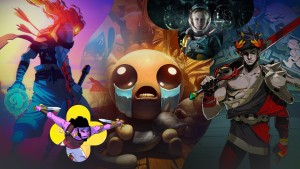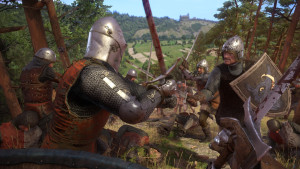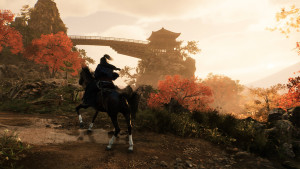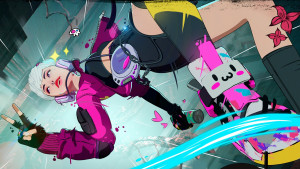Please support Game Informer. Print magazine subscriptions are less than $2 per issue
Rebranding An Icon: Tomb Raider
![]()
Tomb Raider has a long history as both a character and franchise, but where will the brand head as it moves into the future?
Lara Croft and the Tomb Raider franchise have come a long way over the years. Younger gamers may not recall the way the character invaded the cultural landscape in the late 90s, appearing in everything from comic books and toys to theme park rides. We took a look back at some of the features that shaped the character and the game series in the past, and more importantly, spoke with Crystal Dynamics about what it will take to relaunch Tomb Raider with a brand new vision. ![]() “We got contacted not so long ago from someone looking to renew a contract for a strange water park ride in south Italy, where they have a girl dressed up as Lara Croft who comes out every single day and starts the ride,” laughs Karl Stewart, global brand director for the new Tomb Raider franchise. “And we were like: ‘We do what? Are you serious?’ There was a time when that must have made perfect sense.” From the moment that the first Tomb Raider game launched in 1996, the character had a special appeal. One of only a handful of true video game heroines, Lara Croft was capable and deadly, smart and resourceful, and for many audience members, undeniably sexy. Her twin guns and curvaceous figure cast a big shadow for other characters to follow in the coming years. Even as the years passed, her look and demeanor continued to evolve.
“We got contacted not so long ago from someone looking to renew a contract for a strange water park ride in south Italy, where they have a girl dressed up as Lara Croft who comes out every single day and starts the ride,” laughs Karl Stewart, global brand director for the new Tomb Raider franchise. “And we were like: ‘We do what? Are you serious?’ There was a time when that must have made perfect sense.” From the moment that the first Tomb Raider game launched in 1996, the character had a special appeal. One of only a handful of true video game heroines, Lara Croft was capable and deadly, smart and resourceful, and for many audience members, undeniably sexy. Her twin guns and curvaceous figure cast a big shadow for other characters to follow in the coming years. Even as the years passed, her look and demeanor continued to evolve.
Along the way, numerous media beyond games got in on the action. Comic book maker Top Cow launched a successful Tomb Raider graphic novel series, one that often integrated with the other major characters of their comic universe. Ballantine Books began a series of three novels that tied in with game continuity. Two major Hollywood movies starring Angelina Jolie did big business at the box office. Through that film licensure, Paramount Parks opened several theme park rides across North America built around the brand. And, of course, as the years passed, nearly a dozen actual video games released. “In the past, a number of opportunities have presented themselves to the IP, and those opportunities have been taken,” Stewart tells us. “And that’s great. But that was for that vision. Now we have a new vision.”![]() In 2006, Crystal Dynamics released their take on the franchise with Tomb Raider: Legend, a newly reinvigorated style that still seemed to stay mostly true to the series roots. The game was met by positive critical and commercial success, but the developers knew that sometime soon a change would be required. After 2008’s Tomb Raider: Underworld, Crystal Dynamics knew the time for that more dramatic change had come. “Iconic characters are a product of their time,” explains franchise director Tim Longo Jr.. “Specifically with franchises, they need to evolve with the times. The ones that don’t get ahead of that problem are going to fail. They’re not going to be around anymore.” But how to take such a well known character and bring back her relevance? “We talked about our medium and audience changing,” Longo continues “It’s not only become bigger, it’s wider on the types of audience members. And our medium has matured as an art form and entertainment.”
In 2006, Crystal Dynamics released their take on the franchise with Tomb Raider: Legend, a newly reinvigorated style that still seemed to stay mostly true to the series roots. The game was met by positive critical and commercial success, but the developers knew that sometime soon a change would be required. After 2008’s Tomb Raider: Underworld, Crystal Dynamics knew the time for that more dramatic change had come. “Iconic characters are a product of their time,” explains franchise director Tim Longo Jr.. “Specifically with franchises, they need to evolve with the times. The ones that don’t get ahead of that problem are going to fail. They’re not going to be around anymore.” But how to take such a well known character and bring back her relevance? “We talked about our medium and audience changing,” Longo continues “It’s not only become bigger, it’s wider on the types of audience members. And our medium has matured as an art form and entertainment.”
![]()
The Lara Croft: Tomb Raider film opened up an entirely new audience for the franchise, but gamers had mixed impressions of the treatment
![]()
Over the years, Tomb Raider has usually had a live-action model to portray Lara at public events
Into the transition period stepped a wholly new concept. Lara Croft and the Guardian of Light released on XBLA earlier this year, and just today on iOS platforms. The new game serves as a break from the traditional style seen from previous games in the franchise, focused on fast and fun action and exploration. “We called it Lara Croft and the Guardian of Light because we wanted to call attention to the fact that it wasn’t trying compete with the pillar releases,” Crystal Dynamics head of studio Darrell Gallagher tells us. “Because it was a very different type of product in the Tomb Raider universe, we felt it was important to make that distinction clear. It’s something we’ll be open to for other products, should we see fit. If they’re not the pillar products, then we have this Lara Croft sub-brand that absolutely can be applied to other releases that may live between those pillar games.” If nothing else, the presence of Guardian of Light served to alert fans: Big changes were on the way for their favorite British heiress. ![]() With so much brand history across so many mediums, it was a challenging task to break down what should stay and what should go. “When we began the process of going down this road, the first thing we did was look at where we currently stood,” Stewart says. “What was available, and what was out there. And once you have this new vision, you have to be able to manage that, and create a clear vision for the future.”
With so much brand history across so many mediums, it was a challenging task to break down what should stay and what should go. “When we began the process of going down this road, the first thing we did was look at where we currently stood,” Stewart says. “What was available, and what was out there. And once you have this new vision, you have to be able to manage that, and create a clear vision for the future.”
The Lara Croft of previous generations had a plastic and unfeeling quality about her, both in the way she appeared and the way she interacted with the world. She seemed indestructible and at times unfeeling. So that’s where the team at Crystal Dynamics started. After tearing down everything they thought they knew about the character and the series, they started building back up around the concepts that needed to stay. “Characters are way more important in games now. Lara had always stayed in that 2-dimensional Teflon. It was more about the raw fantasy fulfillment of doing what she was doing, rather than her being someone that people cared about,” says Longo. “You have to give things to people before they know they want them.”
That vision began to take shape. The new Tomb Raider was younger. Less entitled. Capable, but human. Vulnerable of real and painful injury. Reliant on others, but with an independent streak. And as for the series gameplay, concept, and story? “We needed to modernize her. It was sort of like reverse engineering,” Longo tells us. “We started with simple premises like, we need to put her on the defensive. We need to put her in a place where she is stripped of resources, and she’s forced to react to that situation.” Crystal decided that an origin story was in order – an entirely new take on Lara’s life that abandoned all previously held conceptions of who and what she was. In order to become the Tomb Raider, Lara would need to go through a terrible ordeal, and survive a seemingly impossible scenario. The Tomb Raider game concept that emerged had many similarities to the recent James Bond films, or the Nolan Batman films – true to the character concept, but free to move in new directions.
With that new vision established, the question now becomes, where to go from here. “It’s a case of not trying to run before we can walk,” Stewart says. “We have a very, very unique vision that we’re trying to portray. We need to have a structure. And that structure is an umbrella. Our Tomb Raider game fits right in the middle – that holds everything together. And everything that we do moving forward has to fit back to that pillar. That’s not to say we wouldn’t do auxiliary products, but even by doing that you have to look at it and say: does that fit within our world?”
![]()
Many players, including the developers at Crystal Dynamics, felt that the old Lara Croft's in game persona was too much like her toys: hard and plastic
So, for now, it seems that fans shouldn’t hold their breath for an immediate continuation of comic books and other related branding. The survival themes present in the new origin story game will dictate a new direction for the series, ideally not diluted by lunch boxes or advertisement appearances. Another thing to disappear is something that’s been an unusual staple of the brand for years. “For this game, we don’t feel like it’s right to try and portray this through a live-action model,” Stewart tells us. “It has to be the character in the game. We just don’t imagine seeing a real-life female version of this character running around.”
What about exploring the opposite direction? Could the new Tomb Raider, with her modernized image, be a place to find brand intrusions from the outside world? Maybe, and maybe not. “There’s a line you don’t want to cross,” Stewart assures us. “There’s games that you look at, and you think, that’s just blatant advertisement. It peeves people off. There’s a fine line between doing that and placing the character in a real world that makes it feel genuine. It’s grounding the character in the world. We’d never look at the game and say, ‘hey we’ve got this great IP, lets go find some brands to put into it.’”
In our time with Crystal Dynamics, one thing was abundantly clear. The developers behind the new game have some big ideas about the new direction for the franchise. Tomb Raider, as a brand, carries a lot of baggage for gamers. Some of it is good, as memories surface of great memories playing the earliest entries in the series. Some of it is undeniably bad, like the resentment many gamers began to feel over the years about the way Lara Croft’s virtual sex appeal became synonymous with gaming among many outsiders. It’s a big task to take those varied recollections, and force a gaming public to throw them away in favor of a new vision. But that’s exactly what the team at Crystal Dynamics hopes to do, and our time seeing the game in action indicates that they’re well on their way.
For more on Tomb Raider, check out our ever-growing hub of new content, updated all this month, by clicking on the banner below.










